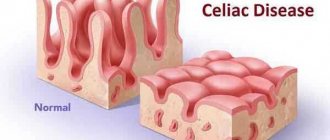Vitamin A is a collective concept for a number of compounds that are similar in structure. These include: retinol, retinal, retinoic acid, deroretinol.
Retinol is the true vitamin A, found in animal foods, while its precursor, carotene, is found in plant foods. The daily requirement for men is 900 mcg, for women - 700 mcg, and in pregnant women it is higher. It is worth considering that its excess intake is fraught with hypervitaminosis, accompanied by symptoms of intoxication. The maximum safe dose for adults is 2500–3000 mcg per day.
Role in the body
Among the biological functions it is worth noting:
- participates in the synthesis of enzymes necessary for the formation of mucopolysaccharides, hyaluronic acid, heparin, taurine;
- participates in the synthesis of liver enzymes;
- promotes the production of somatomedins, which are responsible for the formation of muscle proteins, nucleic acids, and collagen;
- is a structural component of cell membranes;
- participates in the synthesis of sex hormones and immune factors;
- responsible for the growth, reproduction and differentiation of epithelial tissues, prevents their keratinization;
- participates in vitamin D metabolism;
- is a key component in the synthesis of rhodopsin, a pigment necessary for twilight vision.
Forms of Vitamin A
There are 3 forms of vitamin A:
- retinols (the most active form, mainly found in foods of animal origin);
- beta-carotenes (plant sources of the vitamin);
- carotenoids (exist in free alcohol or in fatty acyl ester form, the most numerous group).
The pharmacological form of release is also different:
- dragee;
- drops for internal use;
- oil solution;
- capsules;
- film-coated tablets;
- injection.
Biological role
Vitamin A affects the barrier function of the skin, mucous membranes, the permeability of cell membranes and the biosynthesis of their components. The effect of vitamin A in these cases is associated with its involvement in protein synthesis.
Currently, the importance of vitamin A in the process of photoreception has been clarified in more detail.
The retina of most vertebrates contains two photoreceptor systems: the rod apparatus, sensitive to low light intensity, i.e. twilight vision and cone vision - adapted to high light intensity and for color vision. Photosensitive pigments, called rhodopsin, are chromoproteins consisting of a chromophore group - vitamin A-aldehyde (retinal) and a protein - opsin. The cone photoreceptor systems (iodopsin and cyanopsin) consist of the same chromophore groups connected to a protein that is structurally different from opsin. In the light, rhodopsin is broken down into the protein opsin and retinal; the latter transforms into a trans form; These transformations are associated with the transformation of the energy of light rays into visual stimulation. In the dark, the reverse process occurs - the synthesis of rhodopsin, which requires the presence of an active form of aldehyde - 11-cis-retinal, which can be synthesized from cis-retinol or trans-retinal, or the trans form of vitamin A with the participation of specific dehydrogenases and isomerase.
Under the influence of a quantum of light, rhodopsin, through a series of intermediate products (“orange” and “yellow” proteins), breaks down into opsin and allo-trans-retinal, which is an inactive form of vitamin A aldehyde. Allo-trans-retinal can be partially converted into active 11-cis -retinal under the influence of light (dotted arrow in the diagram). However, the main route of formation of 11-cis-retinal is the enzymatic conversion of the trans form of vitamin A into the cis form (under the action of isomerase), and its subsequent oxidation with the participation of alcohol dehydrogenase.
Beneficial features
Each vitamin has its own function in the body. Retinol has several of them.
- It has a positive effect on the functioning of the visual organs. This is a means of preventing senile blindness.
- Vitamin A is essential for maintaining the integrity and function of skin cells, as well as the respiratory and digestive systems.
- Retinol plays an important role in the development of lymphocytes (white blood cells). They are key agents in the immune system response.
- Prescribed for pregnant women: participates in the growth of limbs, the formation of the baby’s heart, eyes and ears. Also responsible for growth hormone: a deficiency can provoke a birth defect.
- Considered a strong antioxidant. It has the ability to neutralize free radicals that lead to the development of chronic diseases (for example, diabetes).
- Retinol is the key to healthy bones. With enough of it, the risk of fractures is reduced by 6%.
Clinical trial results
Visual symptoms
Characteristic symptoms of vitamin A deficiency in humans are eye lesions, including disorders of the retina, conjunctiva and cornea. The twilight vision disorder, known as night blindness, or hemeralopia, which deprives a person of orientation in space and the ability to move in the dark at dusk, is one of the early manifestations of vitamin A deficiency. Much later, the disorder of night vision is accompanied by lesions of the conjunctiva and cornea. The weakening of dark adaptation is associated with a decrease in the supply of vitamin A in the form of vitamin A-aldehyde to the retinal rods. Weakening of night vision long before the development of subjective manifestations of hemeralopia can be detected by scotometry, dark adaptation studies and electroretinography.
Morphological changes in the eye with vitamin A deficiency appear later than dark adaptation disorders. They arise as a result of keratinization of the epithelium of the conjunctiva, cornea and cessation of secretion of the lacrimal glands, which together leads to the development of xerosis. To more accurately describe the eye condition specific to vitamin A deficiency, it is recommended to use the narrower terms “conjunctival xerosis” and “corneal xerosis.” Conjunctival xerosis appears as one or more patches of dry, non-wetting conjunctiva. The spots are best seen in side lighting. Typical xerosis may be accompanied by varying degrees of thickening of the conjunctiva, its wrinkling and pigmentation. There is a decrease in the sensitivity of the bulbar conjunctiva, photophobia, and a feeling of the presence of a foreign body in the eye (“sand sensation”). Along with general changes in the conjunctiva, limited xerotonic changes can be observed on it - Bitot's plaques located on the conjunctiva of the sclera.
In older children, adolescents and adults, eye changes are limited to xerosis. In contrast, in infants and children under 4 years of age, eye changes due to vitamin A deficiency often extend to the cornea. Damage to the cornea begins with xerosis, decreased sensitivity and progressive opacification. Subsequently, keratomalacia develops, passing into the stage of infiltration, ulceration, softening and perforation. Keratomalacia often results in complete or partial loss of vision.
Application in medicine
For each disease, a different vitamin A derivative and corresponding dosage are prescribed. Before starting treatment, it is important to consult a specialist and take tests to determine the level of vitamin A in the body. Your doctor may prescribe retinol in the following cases:
- protein deficiency;
- overactive thyroid gland;
- cataract;
- recent laser eye surgery (healing occurs faster);
- retinal damage (eye diseases progress more slowly);
- malaria;
- complications during or after pregnancy (especially if a woman is not able to eat properly);
- peeling and rashes on the skin.
Physicochemical properties and structure
Carotenoids and carotenes
Carotenoids belong to a large group of hydrocarbon compounds - pigments synthesized by higher plants, fungi, and bacteria. According to their structure, carotenoids can be divided into a number of groups: carotenoids themselves, hydroxyl-containing carotenoids, carotenoids containing carbonyl groups, etc. Carotenoids themselves are designated by the term “carotenes”. Carotenoids of other groups, containing oxygen in their molecule, should be considered as derivatives of carotenes. Carotenoids and carotenes are capable of forming structural and spatial isomers.
The undoubted and so far only indicator of the biological value of carotenoids is their ability to be converted in the body into vitamin A. Carotenoids capable of such conversion are collectively called provitamins A. These include structural isomers of carotene - alpha, beta and gamma carotenes.
The most common structural isomer is beta-carotene, the molecule of which consists of two beta-ionone rings connected by an aliphatic chain having 9 unsaturated double bonds. One such bond is found in each ionone ring. Alpha-carotene, with the same structure of the aliphanic chain, contains only one beta-ionone ring, while the second ring is replaced by an alpha-ionone ring. Gamma-carotene contains 12 unsaturated double bonds, one beta-ionone ring and an open ring at the other end of the molecule.
The provitamin activity of structural and spatial isomers of carotene is different. The trans-transform of any isomer has the most pronounced provitamin activity. Among the individual structural isomers, beta-carotene is the most active, the activity of which is taken as 100%. Compared to beta-carotene, the activity of alpha and gamma carotene and cryptoxanthin is 53, 27 and 57%, respectively. The lower activity of cis-isomers compared to the trans-trans form can be explained by the fact that the carotenoid molecule, as a result of trans-trans isomerization, loses its original structure, which hinders the action of the enzyme system or systems involved in the conversion of this carotenoid into vitamin A.
Vitamin A and its derivatives
The chemical properties and structural formula of vitamin A were established back in 1931. At the same time, it was shown that it is an unsaturated alcohol with the empirical formula C20 H30 O, with five double bonds - one in the beta-ionone ring and four in the aliphatic side chain. Crystalline preparations of vitamin A were obtained in 1937. Vitamin A is a cyclic unsaturated monohydric alcohol that is soluble in most organic solvents, unstable in the presence of atmospheric oxygen, sensitive to light and heat, forms ethers and esters, most of which are more stable than itself vitamin A.
When oxidized in the body, vitamin A alcohol (retinol) is converted into vitamin A aldehyde (retinal). In addition to vitamin A alcohol, its esters and aldehyde, natural derivatives of vitamin A include 3-dehydrovitamin A, or vitamin A2, and some stereoisomers of these vitamins. Apparently, vitamin A acid (retinoic acid) can also be considered a natural compound of vitamin A.
Physicochemical properties and biological activity of vitamin A and its derivatives
| Vitamin A and its derivatives | Molecular melting point weight | Absorption maximum in standard in nm | E1 cm at 328 nm in the reference | Biological activity of ME/gXI-6 | |
| Alcohol | 286,4 | 64 | 324-325 | 1780 | 3,33 |
| Esters: | |||||
| acetic | 328,5 | 57-58 | 326 | 1510 | 2,91 |
| palmitic | 524,8 | 27-28 | 325-328 | 940 | 1,6 |
| p-phenylazobene- | |||||
| ashy | 494,6 | 80 | 330 | 1550 | |
| amber | 654,9 | 77-78 | 325-328 | 1240 | 2,5 |
In scientific research
Science never stands still. For example, many diseases that were once considered deadly can now be successfully treated. Vitamins are part of almost all enzymes and, together with them, are accelerators of metabolic processes. Research on the importance of the role of vitamins in human life does not stop for a minute.
- Scientists from Sweden have discovered the effect of vitamin A on human embryonic development. Retinol is involved in the formation of blood cells and helps form different types of tissue in the growing fetus.
- Researchers at Case Western Reserve University have found that uncontrolled vitamin A metabolism in the gut can trigger severe inflammation.
- Retinol increases the activity of cells responsible for producing insulin. Beta cells have a huge number of receptors sensitive to vitamin A.
In cosmetology
Cosmetologists say: retinol is the gold standard in skin care. This is practically a magician who solves all problems (from acne to wrinkles). The positive effect is observed in the following:
- increased elastin production;
- stimulating the formation of new blood vessels;
- decreased activity of the sebaceous glands;
- reduction of sebum secretions;
- provoking the exfoliation of dead cells (a means of preventing clogging of pores).
Vitamin A source foods
Vitamins serve as catalysts and regulators of biochemical reactions. If you need vitamin A, you should definitely have the following products in your refrigerator.
- Carrot. The vegetable is rich in beta-carotene, which is converted into vitamin A in the body. Absorption occurs only together with fats: carrots are consumed with sour cream, cream or butter.
- Cod liver. Contains a large amount of fish oil, which are healthy Omega-3 fatty acids that help absorb vitamins.
- Spinach. Called the "king of greens." It is the leader among vegetables not only in terms of vitamin content, but also vegetable proteins and fiber.
- Avocado. In addition to all kinds of vitamins, the fruit is rich in monounsaturated fats that are easily absorbed by the body. At the same time, it gives you a feeling of satiety for a long time.
- Vegetable oil. In oils, vitamin A is present in the form of its precursors from a fairly large family of carotenoids. They color plant tissues yellow or orange.
- Butter. Contains about 80% fat and 4 hundred different fatty acids, without which the normal functioning and growth of the body becomes impossible.
Contraindications and precautions
Consuming excess amounts of vitamin A can be dangerous to your health. With a balanced diet, the daily dose can be easily obtained without the use of specific additives, from ordinary products. For adults, the upper daily limit is 3,000 mcg (10,000 IU). Very high doses can cause severe poisoning and even death.
Overdose symptoms:
- Deterioration of visual function.
- Joint pain, bone pain.
- Lack of desire to eat.
- Nausea and vomiting.
- Photosensitivity.
- Baldness.
- Headache.
- Dry skin.
- Liver damage.
- Yellowing of the skin.
- Stunted growth.
- Dizziness.
- Skin itching.
Excessive amounts of vitamin A are dangerous during pregnancy. Overdose carries a risk to the health of the mother and fetus. There is evidence that hypervitaminosis of vitamin A increases the risk of developing lung cancer in smokers. Therefore, you need to take retinol supplements carefully and strictly follow the dosage.
Signs of severe vitamin A deficiency
Vitamin A deficiency develops if a person consumes few foods containing this substance. Alcoholism and malabsorption aggravate the situation. You can understand that the body is experiencing a lack of vitamin A by the following signs:
- Night blindness. This is the first signal of existing hypovitaminosis.
- Corneal ulcers. With severe vitamin A deficiency, vision can be lost completely.
- Immunodeficiency.
- Frequent respiratory infections. Among children with vitamin deficiency, there is a higher mortality rate from measles.
- Diarrhea.
- Impaired growth and bone formation.
- COPD, pulmonary emphysema. Obstruction most often develops in smokers.
Signs of excess vitamin A
Symptoms of acute vitamin A hypervitaminosis:
- Nausea.
- Headache.
- Decreased performance.
- Loss of appetite.
- Dizziness.
- Dry skin.
- Brain swelling.
Chronic hypervitaminosis of vitamin A can cause the development of osteoporosis, as well as birth defects in the fetus. In this regard, retinol derivatives are especially dangerous, so it is better for pregnant women to be prescribed beta-carotene.
People with an increased risk of lung cancer, smokers, and people whose bodies are exposed to asbestos should not take vitamin A supplements for a long time.
How much vitamin A do you need?
The daily intake of certain micronutrients into the body is necessary for full functioning. The daily requirement of vitamin A varies for different categories of people:
- for children up to six months, 0.4 mg per day is required;
- from six months to three years - 0.6 mg;
- for preschoolers and primary school students, 0.9 mg is required;
- for adolescents - 1.7 mg;
- pregnant and lactating women are prescribed 3 mg;
- men - 2 mg;
- for elderly people, 0.8 mg is sufficient.
The effect of hypovitaminosis on other organs
One of the clinical manifestations of vitamin A deficiency is skin changes known as follicular hyperkeratosis. The initial sign of skin changes is dryness and roughness of the skin, caused by increased keratinization of the surface epithelium and suppression of the activity of the sweat and sebaceous glands. Subsequently, skin changes occur according to the type of follicular hyperkeratosis and dryness is replaced by a papular rash. The rash occurs on the outer and lateral surfaces of the thighs, the back and lateral surfaces of the forearms, spreading further to the rest of the body.
In addition to the characteristic symptoms of vitamin A deficiency in humans and animals, symptoms such as growth inhibition, loss of body weight, and general exhaustion of the body also appear.
Signs of deficiency
Vitamin deficiency is a pathological condition associated with a deficiency of a substance in the body. You can suspect something is wrong based on the following symptoms:
- deterioration of visual acuity;
- dry skin;
- respiratory tract diseases;
- long-term healing of wounds and skin abrasions;
- slow growth (in childhood);
- white spots on the oral mucosa;
- painful perception of bright light;
- dandruff;
- acne.;
- brittle nail plates.
Interaction with other drugs
To support vitality and prevent a number of diseases, many people prefer to use multivitamin complexes. When choosing such drugs, it is important to consider the compatibility of vitamins.
- Vitamin A entering the blood will be destroyed instantly if there is no vitamin E in the body. But the latter should be less than the former.
- With a deficiency of vitamin B4 (choline), vitamin A is not stored for future use.
- Vitamin F enhances the properties of retinol.
- Vitamin D cannot be combined with vitamin A: they neutralize each other’s effects.
- Vitamin B2 increases the healing properties of zinc, and the microelement, in turn, improves the absorption of A.










